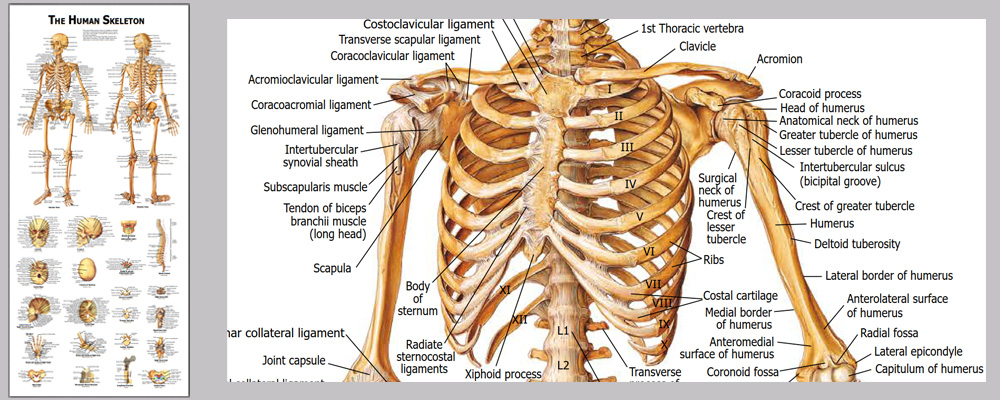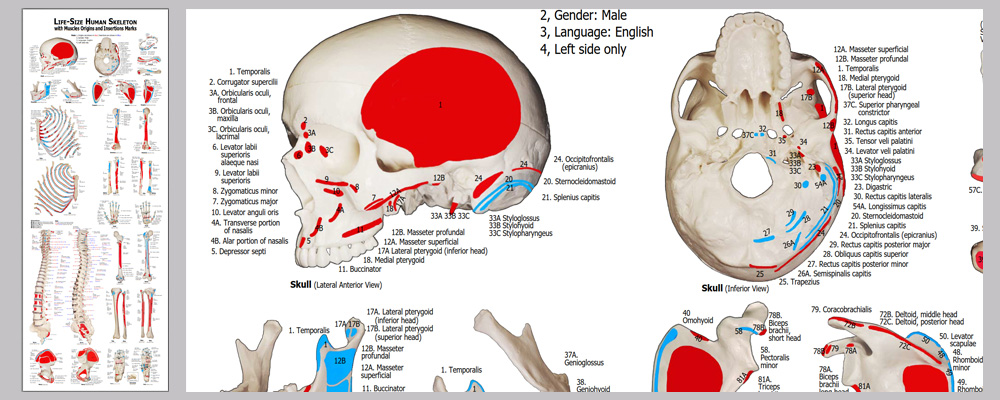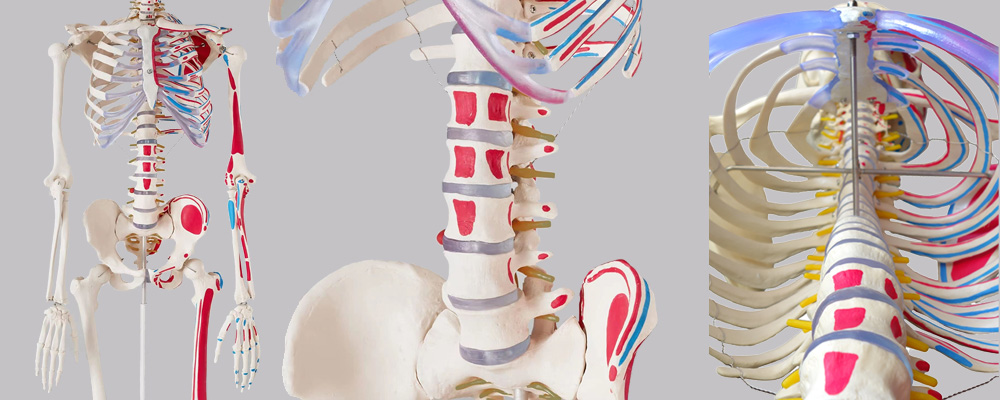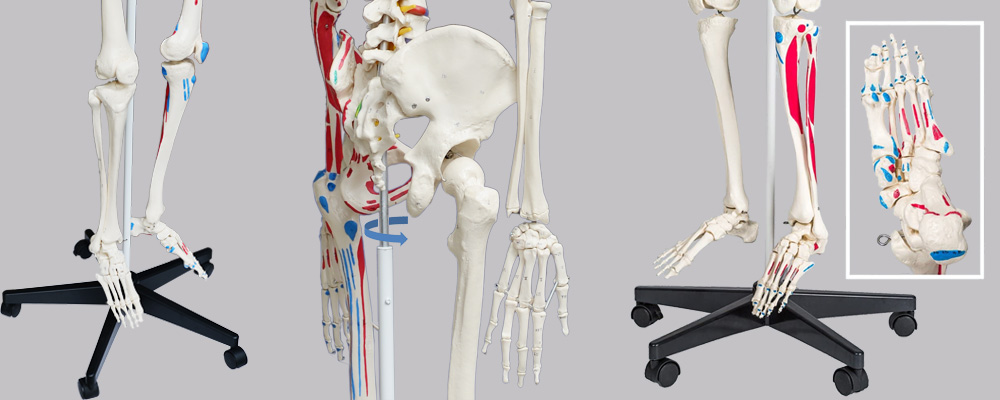human skeleton study model
This life size articulated adult human skeleton model is 180cm tall & ideal for teaching / learning the basics of human anatomy. Includes a colorful Human Skeleton chart to show all the detailed structures for reference.Detailed colorful chart with over 630 accurate definitions. Durable and no reflection with matte film covered, 36 * 78cm

Detailed muscles origins and insertions with codes. Durable and no reflection with matte film covered, 100cm * 38cm

Stainless steel wires keep the ribs gaps stable.

2 of 5 casters are lockable.

With JC anatomy, you can also demonstrate the movements of the skull via the head joints, and thanks to the fully flexible spine, you can adjust the human skeleton study model to place it in natural body postures. The unique combination of muscle origins and insertions, the numbered bones, flexible ligaments and flexible spine with a slipped disc between the 3rd and 4th lumbar vertebrae clearly the show medical and anatomical interest of this top model's more than 688 structures. Now available on a stable metal stand with 5 casters!
| Product name | human skeleton study model |
| Place of Origin | Shenzhen China |
| Product Material | PVC, ABS, SST |
| Rib cage | A 5mm dia |
| Human skeleton model life | 12years |
| Surface treatment | Polish. Etched. Texture |
| SUPPORT 24/7 | Contact us 24 hours a day, 7 days a week |
| Size | 78 * 36 * 132 |
| Port | Shenzhen |
| PAYMENT & ORDERING | PayPal account or pay by credit card |
human skeleton study model FAQs Guide Are you looking for a quick review guide about human skeleton study model? An ultimate FAQs buying guide is available to help you.This guide contains all the information about all the important facts, figures, and various processes regarding human skeleton study model. Let’s continue!
2.human skeleton study model Are accompanying labels provided indicating the name and location of each bone?
3.Does the manufacturer of this human skeleton study model provide relevant anatomy teaching materials?
4.Does this human skeleton study model include all human skeletal systems?
5.About human skeleton study model origin
6.Why is a human skeleton study model important in medical education?
7.Can this human skeleton study model be used as a simulation tool for sports training?
8.How many movable joints does human skeleton study model have?
9.About human skeleton study model warranty
10.About human skeleton study model production capacity
11.How to correctly assemble and utilize a human skeleton study model?
12.Can the human skeleton study model be disassembled and assembled to facilitate learning and display?
13.Does the human skeleton study model have movable joints that can show the range of motion of various parts of the human body?
1.What kind of material is used to make the human skeleton study model?
The human skeleton model is typically made out of a combination of materials, depending on the specific model and its intended use. Generally, the main materials used are plastic, metal, and sometimes, natural materials such as wood. Plastic: The majority of the skeleton model is made from a high-quality, durable plastic such as polyvinyl chloride (PVC) or polyethylene. These materials are lightweight and easy to mold into the intricate and specific shapes required for each bone in the skeleton. They are also easy to paint and can be colored to resemble real bones.
2.human skeleton study model Are accompanying labels provided indicating the name and location of each bone?
The stardard model does not provide this function. The chart shipped with pro model shows the name and location of each bone
3.Does the manufacturer of this human skeleton study model provide relevant anatomy teaching materials?
Yes, we provide a series charts to support teaching and learning
4.Does this human skeleton study model include all human skeletal systems?
It depends on the model in question. Some Human skeleton models may include all human skeletal systems such as the axial skeleton (skull, vertebral column, ribcage), appendicular skeleton (arms, legs, shoulder girdle, pelvic girdle), and cartilaginous skeleton (cartilaginous structures such as the nose and ears). However, others may only include certain systems or be limited to specific areas of the body. It is important to carefully read the product description or ask the manufacturer for a detailed list of what is included in the model to ensure that it meets your needs.
5.About human skeleton study model origin
Made in China
6.Why is a human skeleton study model important in medical education?
Better understanding of the structure, function, and pathological changes of the skeletal system. Deeper understanding of the pathogenesis of skeletal diseases. To demonstrate and explain treatment methods for skeletal diseases
7.Can this human skeleton study model be used as a simulation tool for sports training?
The Human skeleton model can definitely be used as a simulation tool for sports training. This model can be used in various ways to simulate different scenarios and movements that are specific to different sports. In conclusion, the Human skeleton model is a versatile tool that can be used to enhance sports training in various ways. It can help athletes and coaches understand and improve technique, prevent injuries, analyze and correct movement patterns, and simulate specific sports movements and scenarios. Thus, it can be a valuable resource for individuals looking to train and improve their performance in sports.
8.How many movable joints does human skeleton study model have?
There are approximately 13 movable joints in the human skeleton model, with different types of joints including ball and socket, hinge, pivot, gliding, and saddle joints. These joints allow for a wide range of movements, such as flexion, extension, rotation, abduction, and adduction.
9.About human skeleton study model warranty
3 years. If any problem occurs with the model due to material or structural defects, it will be repaired or replaced free of charge to the buyer
10.About human skeleton study model production capacity
600pcs each month
11.How to correctly assemble and utilize a human skeleton study model?
When assembling and utilizing a human skeleton model, there are several steps to follow to ensure correct positioning and accurate representation of the skeletal system. Below is a step-by-step guide to properly assemble and utilize a human skeleton model: 1. Gather all the necessary components: The first step is to gather all the pieces of the human skeleton model, which typically includes a skull, rib cage, spinal column, arms, and legs. Make sure that all the pieces are present and in good condition. 2. Identify the bones: Before assembling the skeleton, it’s important to familiarize yourself with the different bones and their names. The skull, for example, has different parts such as the cranium, mandible, and maxilla, while the spinal column consists of the cervical, thoracic, lumbar, sacrum, and coccyx vertebrae. 3. Attach the arms and legs: Next, attach the arms and legs to the skeleton. Start by connecting the arms to the shoulder sockets and then attach the hand bones to the arms using the elbow and wrist joints. For the legs, connect the femur (thigh bone) to the hip socket, followed by the tibia and fibula (lower leg bones), and finally the foot bones.
12.Can the human skeleton study model be disassembled and assembled to facilitate learning and display?
Yes, many human skeleton models are designed to be disassembled and assembled for educational purposes. The bones are typically connected by metal or plastic clips that can be easily removed and reattached, allowing for the skeleton to be taken apart and put back together. This feature makes the model useful for learning about the different bones and their connections, as well as their placement in the body. Students can learn the names and locations of each bone by taking them apart and reassembling them in the correct order. This hands-on approach can be helpful for visual learners and can make the learning process more engaging and interactive.
13.Does the human skeleton study model have movable joints that can show the range of motion of various parts of the human body?
Yes, the human skeleton model typically has movable joints that can show the range of motion of various parts of the human body. These joints are usually represented by different types of articulations such as ball and socket, hinge, saddle, pivot, and gliding joints, which mimic the movement of the actual joints in the human body. For example, the shoulder joint of a human skeleton model will have a ball and socket structure that allows for a wide range of motion, similar to the shoulder joint in a real human body. This joint is able to rotate 360 degrees and can also move forward, backward, and sideways. Similarly, the elbow joint in a human skeleton model will have a hinge structure that allows for flexion and extension movements, just like the elbow joint in a real human body. This enables the model to accurately demonstrate movements such as bending and straightening of the arm.




